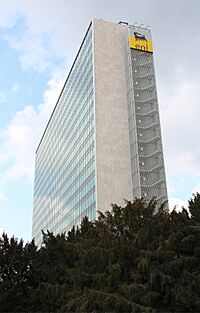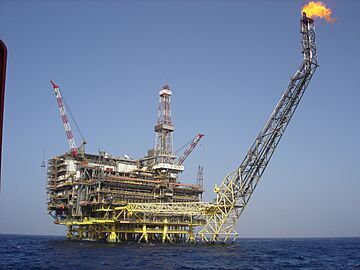Eni facts for kids
 |
|

Palazzo Eni, the Rome headquarters
|
|
| Public S.p.A. | |
| Traded as |
|
| ISIN | ISIN: [https://isin.toolforge.org/?language=en&isin=IT0003132476 IT0003132476] |
| Industry | Oil and gas |
| Founded | 10 February 1953 |
| Founder |
|
| Headquarters |
,
Italy
|
|
Area served
|
Worldwide |
|
Key people
|
|
| Products | Petroleum, natural gas, petroleum products |
| Revenue | |
|
Operating income
|
|
| Total assets | |
| Total equity | |
| Owner |
|
|
Number of employees
|
32,492 (2024) |
| Subsidiaries | Enilive, Eni Plenitude, Versalis, Eni Rewind, EniPower, EniProgetti, Saipem, Agenzia Giornalistica Italia |
Eni S.p.A. is a big Italian energy company based in Rome. It's known as one of the "supermajor" oil companies around the world. The Italian government owns a large part of the company.
Over the years, Eni has worked in many different areas. These include building things, nuclear power, finding energy, mining, making chemicals and plastics, and even the hotel and news industries. Eni is one of the largest Italian companies. It is also a very big petroleum company in Europe and the world.
Contents
Eni's Journey Through Time
How Eni Started: The Early Years (1950s–1960s)
Eni was created in 1953 from an older company called Agip. Agip started in 1926 to find and sell oil. In 1953, Enrico Mattei became Eni's first chairman. The company's famous logo, a six-legged dog, was chosen in 1952. This imaginary dog represents a car's four wheels and its driver's two legs.
In 1954, Eni began to explore for oil in North Africa. They made agreements with countries like Egypt. These deals gave oil-producing countries a fair share. Eni made a similar deal with Iran in 1957. In 1960, Eni also agreed to buy oil from the Soviet Union at low prices.
Enrico Mattei died in a mysterious plane crash in 1962. At first, it seemed like an accident. Later, it was confirmed he was murdered. This was to protect important business and political secrets. After his death, Eni continued to make deals with foreign companies. They brought oil from Egypt, Iran, Libya, and Tunisia. In 1963, Eni also bought a large part of Italgas, a gas company.
Growing Stronger: The Middle Years (1970s–1980s)
In 1973, there was a big oil crisis. This happened after a war and an oil ban by some countries. Eni became stronger in the world market. They signed a deal with Algeria for natural gas.
In 1974, Eni made more agreements with Libya, Egypt, Nigeria, and Tunisia. In the mid-1970s, Eni planned a huge project. They wanted to build thousands of miles of pipelines. These pipelines would carry natural gas across Europe and the Mediterranean.
The Trans-Mediterranean Pipeline opened, connecting Algeria to Sicily. Eni then signed a new deal with Libya. This was to use Boùri, the biggest oilfield in the Mediterranean. Eni became a more important player in the oil world.
Becoming a Public Company (1990s)
In 1992, Eni became a joint-stock company. This meant parts of the company could be bought and sold. In 1995, Eni's shares were listed on the Italian and New York stock markets.
From 1995 to 1998, Eni sold 70% of its shares to private owners. In 1998, oil prices dropped a lot. Like other big companies, Eni started merging with others. They also bought companies and looked for new oil fields.
New Discoveries and Partnerships (2000s)
Since 2000, Eni has been working on the Kashagan oilfield. This is a major oil discovery in the Caspian Sea.
In 2005, the Blue Stream pipeline opened. This pipeline brings gas from Russia to Turkey. It was a joint project between Eni and Gazprom. In 2007, Eni and Gazprom also studied a project called South Stream. This project aimed to bring Russian gas to Europe across the Black Sea.
Expanding and Innovating (2010s)
In 2010, Eni reached a big production goal in Iraq's Zubair oil field. Between 2011 and 2012, Eni found several large natural gas fields offshore in Mozambique. These included Mamba South, Mamba North, Mamba North East, and Coral 1.
In 2014, Eni found oil offshore in the Democratic Republic of the Congo. Eni also started selling off some of its refining and marketing businesses in Eastern Europe. This was to make the company more profitable.
In 2014, Eni began a plan to change its old oil refineries into biorefineries. These plants make fuel from plants and other natural materials. The first one opened in Porto Marghera, and a second in Gela in 2019.
In 2015, Eni found a huge gas field off the coast of Egypt. In 2016, Eni started "Progetto Italia." This project aims to reuse old industrial areas. It also creates new plants that produce renewable energy. The first solar power plant opened in Assemini in 2018. Another opened in Porto Torres, both in Sardinia.
In 2018, Eni launched its new HPC4 supercomputer. This powerful computer helps find oil and gas fields faster. In 2020, they replaced it with HPC5, which is three times faster. In November 2024, Eni launched HPC6, which is the most powerful supercomputer in Europe. It can do over 600 million billion math problems in one second.
Eni also partnered with MIT in 2018. They funded research into fusion energy. In May 2019, the Rovuma LNG project was approved in Mozambique. This is a joint project with ExxonMobil and CNPC. Eni focuses on building and running the parts that bring the gas out of the ground.
Recent Developments (2020s)
In March 2021, Eni left the Pakistani market. They sold their businesses there to a new company. In 2018, Eni became a major investor in Commonwealth Fusion Systems (CFS). This company, from MIT, is building a fusion reactor. In 2021, CFS successfully tested a key part of their fusion reactor. This showed it's possible to create a fusion chamber using special magnets. This technology could help produce sustainable energy. In December 2021, Eni became the first energy company to invest heavily in magnetic fusion. They partnered with Google and Bill Gates.
In 2022, during the Russian invasion of Ukraine, oil and gas prices went up. This caused Eni and other energy companies to report higher earnings. In May 2022, Eni set up a way to pay for Russian gas in euros and rubles. This was done with the Italian government's agreement and followed international rules.
In June 2022, Eni joined a project with QatarEnergy. This project, called North Field East, is the world's largest LNG project. It began producing gas in 2025. In October 2023, QatarEnergy signed a 27-year deal to supply LNG to Eni.
In August 2023, Eni, Sonatrach, and BP started exploring for oil and gas again in Libya. In January 2024, Eni bought Neptune Energy for $4.9 billion. This included gas fields in Indonesia, Western Europe, Australia, and North Africa.
In March 2024, Eni found new oil and gas off the Ivory Coast. In July 2024, more oil and gas was found offshore Mexico. Also in July 2024, Vår Energi extended its gas supply deal with Eni until 2036. Eni began supplying fuels to the BWT Alpine F1 Team for the 2025 Formula One season.
How Eni Works
Finding and Producing Oil and Gas

Eni focuses on finding new oil and gas fields. They also work to produce more from existing areas. These areas include North and Sub-Saharan Africa, Venezuela, and Kazakhstan. Eni has about 130 companies that help with this work. In March 2022, Eni stopped buying Russian oil.
In 2024, Eni produced about 1.7 million barrels of oil equivalent per day. They also drilled many new wells to find more oil and gas.
Gas and Power
Natural Gas
Eni sells natural gas all over the world. In 2024, they sold about 50.88 billion cubic meters of gas.
Eni also generates electricity at several power plants in Italy. In 2012, Eni produced 25.67 TWh of electricity. Eni supplies gas to many customers. These include large companies, power plants, and homes. They have millions of customers in Italy and other European countries.
Power Generation
Eni has several power plants in Italy that use natural gas:
- Bolgiano – 95 MW
- Brindisi – 1715 MW
- Ferrara – 586 MW
- Ferrera Erbognone – 1785 MW
- Mantua – 1387 MW
- Ravenna – 618 MW
Making and Selling Fuels
Eni is a top company in Italy for making and selling petroleum products. They also sell fuels in Central and Eastern European countries. These include Austria, France, Germany, and Switzerland.
Eni sells fuel at service stations under the Eni and Agip names. They are changing all their service stations to the Eni brand.
Building and Engineering
Eni also works in engineering, construction, and drilling for the oil and gas industry. They do this through their company Saipem. Saipem builds things both offshore (in the sea) and onshore (on land).
Eni's Other Companies
Eni has many important companies that work with it:
- Azule Energy: A joint company with BP that works in Angola.
- Enibioch4in: Makes biomethane, a type of natural gas from plants.
- Eni India: Explores for oil and gas in India.
- Eni Next LLC: Helps new technology companies grow.
- Eni Plenitude: Sells natural gas and electricity to homes and businesses. It also produces energy from renewable sources and has charging stations for electric cars.
- EniPower: Generates and sells electricity.
- EniProgetti: Provides engineering services.
- Eni Rewind: Helps clean up the environment.
- Enilive SpA: Focuses on sustainable ways to travel and offers cleaner products.
- Eni UK: Works in the British part of the North Sea.
- Eniverse: Helps new technology ideas become real companies.
- Export LNG Ltd: Owns a floating plant that turns natural gas into liquid.
- Ieoc SpA: An active company in Egypt.
- LNG Shipping SpA: Transports liquid natural gas by sea.
- Saipem: Builds things for the oil and gas industry. It has built many pipelines, like Blue Stream and Nord Stream 1.
- Versalis: A chemical company that makes plastics and other chemical products. It also focuses on green chemistry.
Being Sustainable
Eni works to be a responsible company. In 2012, it was recognized for being open about its environmental efforts. In 2014, Eni started turning its refineries into biorefineries. These plants make fuel from natural materials.
Eni has worked to reduce its greenhouse gas emissions. From 2020 to 2022, Eni was seen as a top oil company for its goals to cut emissions. This is in line with the Paris agreement to lower pollution. In 2021, Eni partnered with the International Renewable Energy Agency (IRENA) to promote renewable energy.
Who Leads Eni
Board of Directors
As of May 2023, the people who lead Eni are:
- Giuseppe Zafarana, Chairman
- Claudio Descalzi, CEO
- Elisa Baroncini, Director
- Massimo Belcredi, Director
- Roberto Ciciani, Director
- Carolyn Adele Dittmeier, Director
- Federica Seganti, Director
- Cristina Sgubin, Director
- Raphael Louis L. Vermeir, Director
See also
 In Spanish: Eni para niños
In Spanish: Eni para niños
- List of petroleum companies
Images for kids







